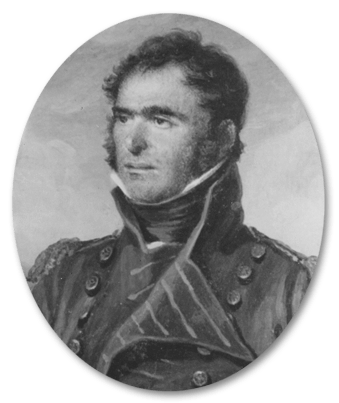Ship's Crew

John Rodgers
Rank(s): Captain
Dates of Service: 11/9/1804 - 5/30/1806, 2/20/1809 - 6/17/1810
Birth Date: 7/11/1773
Death Date: 8/1/1838
John Rodgers was born on July 11, 1773 near Havre de Grace, Maryland. Intrigued by the small vessels arriving at the nearby port, he abandoned school and went to Baltimore, where he apprenticed to a ship’s master. At the end of his apprenticeship, he was rated a mate and, not long thereafter, became a master in his own right. Offered a lieutenant’s commission in 1798, he joined the frigate Constellation under Captain Thomas Truxtun.
On February 9, 1799, during the Quasi-War with France, Constellation defeated the French frigate L’Insurgente. Truxtun made Rodgers the prizemaster, and he successfully navigated the prize home. He was promoted to captain and given command of the sloop-of-war Maryland. In 1801, he delivered to France the ratified peace treaty ending the Quasi-War. Rodgers next commanded the frigate New York in the Mediterranean Squadron from 1802 until the spring of 1803. Rodgers sailed back to the Mediterranean aboard the frigate Congress with an augmented squadron in 1804.
In November 1804, during the first Barbary War in North Africa, Rodgers exchanged Congress for Constitution. After a winter of repairs, the American squadron reassembled off Tripoli to renew the assault begun the previous year. Rodgers relieved an ailing Commodore Samuel Barron as squadron commander, and then participated in negotiations with the Bashaw of Tripoli. The treaty with Tripoli was drawn up in Rodgers’ cabin aboard Constitution. During the following months, Rodgers took the squadron to Tunis and Algiers to convince those governments to keep peace with the United States, and then began sending many of the navy vessels home. He made the rounds of Mediterranean ports, spreading the news of peace between the United States and the Barbary powers of Tunis, Algiers, and Tripoli. In June 1806, he exchanged commands with Captain Hugh G. Campbell on Essex and headed home to command the New York Station.
Late in 1808, a number of larger units of the navy were activated for better high seas law enforcement, including Constitution, which had returned from the Mediterranean a year before and gone into ordinary at New York. Rodgers took command of Constitution, the flagship of the assembled fleet, in March 1809 and began patrolling the Atlantic coast with the purpose of catching vessels in noncompliance with President James Madison’s Non-Intercourse Act of 1809. In mid-1810, President replaced Constitution as the flagship. Rodgers took command of President and Captain Isaac Hull took command of Constitution.
Shortly after the War of 1812 began, Rodgers’ squadron sailed in pursuit of a British convoy, but the cruise proved fruitless. It set the pattern for Rodgers’ wartime service: his several cruises failed to gain him a duel with another frigate and the consequent glory. When the British threatened Baltimore in 1814, Rodgers left President and took a detachment of seamen south. His gunners contributed to the city’s successful defense, and the grateful citizens awarded Rodgers with a silver service valued at $4000. Rodgers next went to Philadelphia to fit out the new frigate Guerriere, but the war ended before the ship could sail.
After the war, Rodgers headed the Board of Naval Commissioners, a panel of senior captains designed to assist the Secretary of the Navy with administration and operations. Rodgers held this position for the rest of his career, barring a two-year period in the mid-1820s when he returned to the Mediterranean as squadron commander. He died on August 1, 1838 and was interred in the Congressional Cemetery in Washington, D.C.